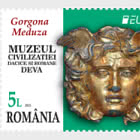Prehistoric Animals
70 million years ago, the territory that is today Tara Hategului was part of a tropical island in the Tethys Ocean, the ocean separating Eurasia from Gondwana, following the fragmentation of the single continent, Pangaea. The island was populated by an exotic association of prehistoric animals, whose remains are today preserved in the rocks of Tara Hategului. Here were discovered numerous sites with bones of crocodiles, turtles, mammals, flying reptiles, birds and a large number of fossils of dwarf dinosaurs, herbivores and carnivores, unique in the world, together with nests of dinosaur eggs.
Lack of permanent links of the island with the mainland areas determined, in time, the adaptation of the dinosaurs’ size to a small space and smaller quantities of food. The dinosaurs that lived here were smaller than those on the mainland, being known in the scientific world as the dwarf dinosaurs of Transylvania. This phenomenon has been termed as insular dwarfism and could also be observed in other types of animals.
Dinosaurs Geopark - Tara Hategului is an area of research, education and sustainable development, committed to preserving the geological, natural and cultural heritage, and strengthening the identity of local communities. It is a natural park and a UNESCO Global Geopark, managed by the University of Bucharest, and member of the European Geoparks Network and the Global Geoparks Network supported by UNESCO.
The postage stamp issue presents prehistoric animals whose fossils were discovered in Tara Hategului and which are important elements in building a Museum of Transylvanian Dinosaurs and the Geopark’s development.
Balaur Bondoc, illustrated on the postage stamp with the face value of 2.00 lei, was a predator dinosaur, having a body length of 1.80 - 2 m, covered with feathers. This predator had a powerful torso and very solid hind limbs with two sickle claws, while the forelimbs were more elongated and equipped with only two functional fingers.
Theriosuchus sympiestodon was a primitive crocodile that lived in Hateg about 70 million years ago. Theriosuchus was a real “living fossil” - it was part of a family whose members had already disappeared in other parts of Europe millions of years earlier. This one is illustrated on the postage stamp with the face value of 3.00 lei.
Magyarosaurus dacus, illustrated on the postage stamp with the face value of 3.30 lei, was a herbivorous dinosaur with a length of 7 m and a height of 3 - 4 m, one of the largest prehistoric animals from the Hateg area. It weighed 800 - 900 kg. It walked on four legs, having a very long neck and tail.
Kogaionon ungureanui is illustrated on the postage stamp with the face value of 14.50 lei. It was a small mammal, described and known only in Tara Hategului. From it, a complete skull was kept, which is extremely rare in mammals during the late Cretaceous.
The philatelic album is created into a limited edition of 245 pcs. and is equipped with the block of 4 postage stamps of the issue and the First Day Cover of the issue, having the “first day” postmark clearly imprinted in green foiling. Both products are numbered from 001 to 245.
The issue is completed by a set of 4 maxicards.
Romania - Recommended stamp issues
WOPA+ recommended stamp issues
| Avatar - Fire and Ash |
| Issued: 03.12.2025 |
| ›New Zealand |
| 50th Anniversary of the Founding of the 24th November Bar Scout |
| Issued: 24.11.2025 |
| ›Montenegro |
| Krisjanis Valdemars |
| Issued: 02.12.2025 |
| ›Latvia |
| Sign Language - Good |
| Issued: 02.12.2025 |
| ›Bosnia and Herzegovina - Republic of Srpska |
| In Memory of the Fallen and Murdered on October 7, 2023 |
| Issued: 08.10.2025 |
| ›Israel |
| Annual Collection Folder (New York) |
| Issued: 05.12.2025 |
| ›United Nations |
| Year Set |
| Issued: 24.11.2025 |
| ›Isle of Man |
| Shipping in the 17th and 18th Centuries - Peat Shipping |
| Issued: 05.12.2025 |
| ›Netherlands |









































